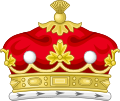| Marquessate of Downshire | |
|---|---|
  Arms: Quarterly, 1st, Sable, on a Fess Argent, between three Leopards passant guardant Or, spotted of the field, as many Escallops Gules (for HILL); 2nd, Party per bend sinister Ermine and Ermines, a Lion rampant Or (for TREVOR); 3rd, Gules, a Quatrefoil Or (for ROWE); 4th, Argent, a Chevron Azure, between three Trefoils slipped per pale Gules and Vert(for ROWE). Crest: A Reindeer's Head couped Gules, attired and plain collared Or. Supporters: Dexter: a Leopard Or, spotted Sable, ducally gorged and chained Gules. Sinister: a Reindeer Gules, attired unguled and plain collared Or. [1] | |
| Creation date | 20 August 1789 [1] |
| Created by | George III |
| Peerage | Peerage of Ireland |
| First holder | Wills Hill, 1st Marquess of Downshire |
| Present holder | Arthur Nicholas Hill, 9th Marquess of Downshire |
| Heir apparent | Edmund Hill, Earl of Hillsborough |
| Remainder to | The 1st Marquess' heirs male of the body lawfully begotten |
| Subsidiary titles | Earl of Hillsborough (I) Earl of Hillsborough (GB) Viscount Hillsborough Viscount Kilwarlin Viscount Fairford Baron Hill Baron Harwich Baron Sandys (UK) |
| Status | Extant |
| Seat | Clifton Castle |
| Former seats | Hillsborough Castle Easthampstead Park |
| Motto | PER DEUM FERRUM OBTINUI (By God and my sword I have obtained) NE TENTES AUT PERFICE (Either attempt not, or accomplish) [2] |
Marquess of Downshire is a title in the Peerage of Ireland. [3] It was created in 1789 for Wills Hill, 1st Earl of Hillsborough, a former Secretary of State.
Contents
- Ancestors
- Viscounts Hillsborough (1717)
- Earl of Hillsborough (1751 & 1772)
- Marquesses of Downshire (1789)
- Line of succession
- Family tree
- See also
- References
- Attribution
- External links
Hill had already been created Earl of Hillsborough and Viscount Kilwarlin of County Down in the Peerage of Ireland in 1751 with remainder, in default of male issue of his own, to his uncle Arthur Hill, 1st Viscount Dungannon. [4] He was further created Baron Harwich, of Harwich in the County of Essex, in the Peerage of Great Britain in 1756 with a seat in the British House of Lords. [5] In 1772 he was further ennobled with a second Earldom of Hillsborough and as Viscount Fairford in the County of Gloucester, both in the Peerage of Great Britain. [6] [1]
Downshire was the eldest son of Trevor Hill, who had been created Viscount Hillsborough and Baron Hill of Kilwarlin in County Down, in the Peerage of Ireland in 1717, with remainder, in default of male issue of his own, to the male issue of his father, Michael Hill. Trevor Hill was the brother of the aforementioned Arthur Hill, 1st Viscount Dungannon. [7] [1]
In 2013, the 9th Marquess succeeded, under the terms of a special remainder of 1802, to the title Baron Sandys. The barony had been created for Mary Hill, Marchioness of Downshire, the widow of the second Marquess, with remainder to her younger sons, Lord Arthur Moyses William Hill, Lord Marcus Hill, Lord Augustus Hill and Lord George Hill successively, but if the male line failed, could be inherited by her male heirs of the eldest son, the third Marquess. This occurred in April 2013 with the death of Richard Hill, 7th Baron Sandys without male heirs. [8]
Prior to the passage of the House of Lords Act 1999, the Marquesses sat in the House of Lords as the Earls of Hillsborough. [9]
Among many other estates, the Marquess owned Hillsborough Castle, Blessington House in County Wicklow, and Easthampstead Park near Bracknell. The Marquesses are also Hereditary Constables of Hillsborough Fort.
The present family seat is Clifton Castle, near Masham, North Yorkshire.

